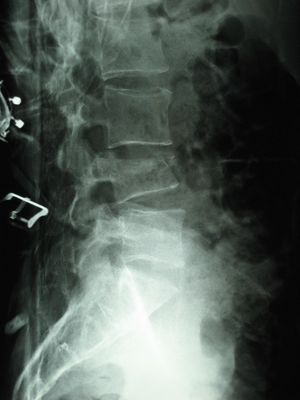Insufficiency Fracture
Original Editor - Lucinda hampton
Top Contributors - Lucinda hampton, Wajeeha Hassan, Kim Jackson and Aminat Abolade
Introduction[edit | edit source]
Insufficiency fractures are a type of stress fracture, which are the result of normal stresses on abnormal bone[1].
- They should not be confused with fatigue fractures which are due to abnormal stresses on normal bone, or with pathological fractures, the result of diseased, weakened bone due to focal pathology such as tumours (both malignant and benign).
- Insufficiency fractures can occur throughout the skeleton but are common in the tibia, femoral head and neck, sacrum, pelvis, and feet. They are most commonly associated with osteopenic or osteoporotic bone and the female athlete triad in young athletes. [2]
- Insufficiency fractures of the spine are often a sign of frailty. There is a reported 23-34% increase in mortality over eight years[3].
L4 insufficiency fracture at R
Epidemiology[edit | edit source]
In general, they are seen in the elderly, more frequently in women.[1]
Pathology[edit | edit source]
- Most often seen in the setting of osteoporosis
- Any process which weakens bone is a risk factor[1].
- If osteoporosis goes untreated, fractures can occur spontaneously without injury (ie insufficiency or fragility fractures).
- The bones are too "fragile" or "insufficient" to support one's weight for simple daily activities such as standing or walking.[4]
Location[edit | edit source]
The most common area for this type of fracture is the pelvis.
- The pelvis helps transfer weight from the legs into the spine and torso.
- The pelvic ring can break anywhere but most commonly occurs in the superior or inferior ramus.
- The second area of breakage is the sacrum[4].
- These fragility pelvic fractures can be painful and are treated with rest, minimizing weight bearing with a walker or crutches, rehabilitation by physiotherapist, and treating the patient with supplemental calcium and vitamin D. These fractures can take 3 to 4 months to heal.
Fragility fracture of the neck of femur.
- The weakest area of the femur is the femoral neck.
- Fractures here usually require surgery to stabilize the bone with screws, plates, or rods.
Fragility fracture of the Sacrum
Fragility fracture of the vertebral (crush or wedge) fractures: very common
- In the case of a fragility fracture, the vertebra compresses into a wedge or triangle.
- This fracture's treatment is usually conservative but sometimes a vertebroplasty (where cement is injected into the bone to help stabilize it) may be performed[4].
Fragility fracture of the proximal third femur
Fragility fracture of the sternum
Fragility fracture of the fibula
Fragility fracture of the tibia[1]
Treatment[edit | edit source]
Treatment depends on the location and whether the fracture is complete or incomplete. Options include:
- Conservative management
- Physiotherapy and rehabilitation services
- Plaster cast
- Internal fixation
- Vertebroplasty
- Kyphoplasty
Treatment of the underlying cause of bone weakness is also essential[1].
Physiotherapy[edit | edit source]
Physiotherapy can play a vital role in the pathway of care of people after fragility fracture and includes interventions of early mobilisation and prescription of structured exercise programmes for maximising functional recovery and reducing the risk of falls and further fractures.[5]
See specific links above and or links to osteoporosis management.
Education can be key to prevention of these fractures.
- Ensure regular Bone density (measured with a DEXA scan) checks
- Take the appropriate measures to prevent your bones from weakening eg diet and weight bearing exercises
- Falls risk education and training.
References[edit | edit source]
- ↑ 1.0 1.1 1.2 1.3 1.4 Radiopedia Insufficiency Fractures Available from:https://radiopaedia.org/articles/insufficiency-fracture (last accessed 12.10.2020)
- ↑ Tranovich MJ, Wright VJ. Insufficiency Fractures. InStress Fractures in Athletes 2015 (pp. 223-237). Springer, Cham.Available from:https://link.springer.com/chapter/10.1007/978-3-319-09238-6_16 (last accessed 12.10.2020)
- ↑ Menu-Professionals M. Non-surgical Management of Insufficiency Fractures of the Spine.Available from:https://www.orthogate.org/articles/spine/non-surgical-management-of-insufficiency-fractures-of-the-spine (last accessed 12.10.2020)
- ↑ 4.0 4.1 4.2 Marcus Daly Memorial Hospital Osteoporotic Insufficiency or Fragility Fractures Available from:https://www.mdmh.org/News/2017/May/Osteoporotic-Insufficiency-or-Fragility-Fracture.aspx (last accessed 12.10.2020)
- ↑ Perracini MR, Kristensen MT, Cunningham C, Sherrington C. Physiotherapy following fragility fractures. Injury. 2018 Aug 1;49(8):1413-7.Available from:https://pubmed.ncbi.nlm.nih.gov/29958686/ (last accessed 13.10.2020)








